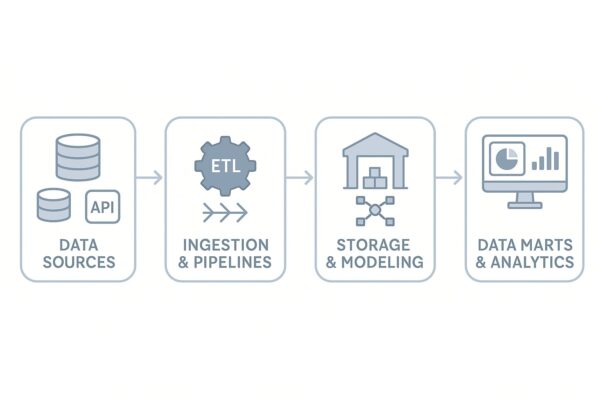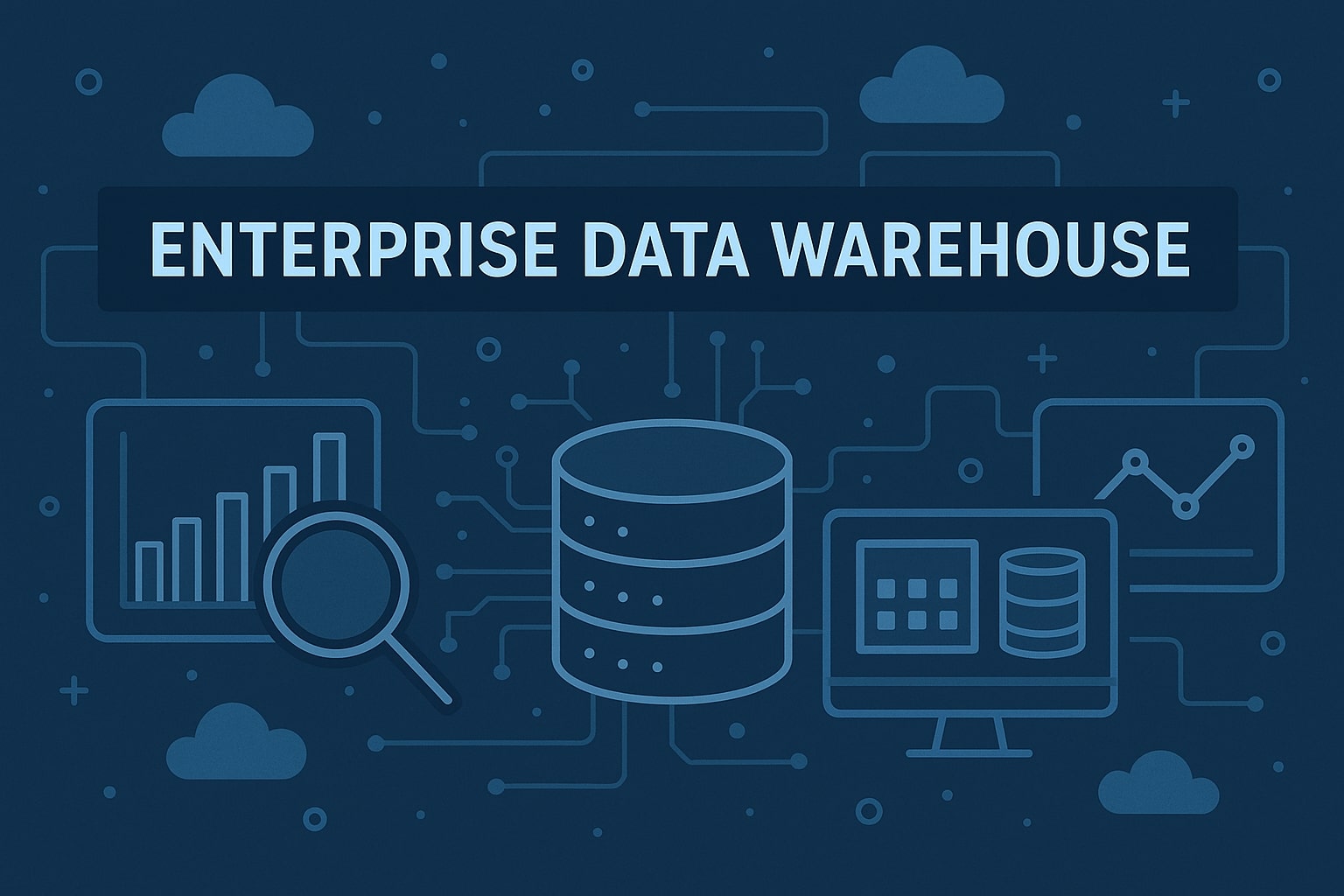An enterprise data warehouse is a centralized repository that integrates structured, analytics ready data from across an entire organization to enable better business decisions. We know that managing data across multiple departments and systems can feel overwhelming, but an enterprise data warehouse solves this challenge by creating a single source of truth for all your company’s information.
When we work with businesses today, we see them struggling with data scattered across different platforms, making it nearly impossible to get a complete picture of their operations. An enterprise data warehouse unifies data from across an organization into one centralized platform, allowing teams to access, analyze, and act on trusted information quickly and efficiently.
The difference between companies that thrive and those that struggle often comes down to how well they use their data. we’ve watched organizations transform their decision making processes by implementing the right enterprise data warehousing solution that supports their unique needs and growth goals.
Key Takeaways
- Enterprise data warehouses centralize all company data into one secure, structured platform for better analytics and reporting
- Modern platforms offer flexible deployment options including cloud based solutions that scale with your business needs
- Proper governance and security practices ensure your data warehouse delivers reliable insights while protecting sensitive information
Core Concepts and Key Differences
Enterprise data warehouses serve as centralized systems that collect and organize business data from multiple sources, while traditional data warehouses typically handle smaller, department specific needs. These systems form the backbone of modern business intelligence and analytics operations.
Definition of Enterprise Data Warehouse
An enterprise data warehouse (EDW) is a centralized repository that stores integrated data from across an entire organization. We can describe it as a comprehensive system that combines information from different departments, applications, and external sources into one unified location.
The EDW differs from basic data storage because it transforms raw data into organized, clean information. This process involves removing duplicates, fixing errors, and standardizing formats so all data follows the same rules.
Key characteristics of an enterprise data warehouse include:
- Subject oriented: Organized around business topics like sales, customers, or products
- Integrated: Combines data from multiple systems and sources
- Time variant: Stores historical data to show changes over time
- Non volatile: Data remains stable once loaded and does not get deleted
The system supports large volumes of data and handles complex queries from many users at once. Most EDW systems can process terabytes or petabytes of information while maintaining fast response times.
Enterprise Data Warehouse vs Traditional Data Warehouse

Traditional data warehouses typically serve single departments or specific business functions. We find that these systems work well for smaller organizations or teams with focused data needs.
Enterprise data warehouses scale across entire organizations and handle much larger data volumes. They support hundreds or thousands of users simultaneously and integrate with more source systems.
| Feature | Traditional Data Warehouse | Enterprise Data Warehouse |
|---|---|---|
| Scope | Department or function specific | Organization wide |
| Data Volume | Gigabytes to low terabytes | Terabytes to petabytes |
| Users | 10s to 100s | 100s to 1000s |
| Sources | Limited internal systems | Multiple internal and external |
| Cost | Lower initial investment | Higher but better ROI |
EDW systems require more planning and governance. They need stronger security controls because they contain sensitive data from across the company.
The architecture of enterprise data warehouses also differs significantly. They use more sophisticated tools for data integration, quality management, and performance optimization.
Role in Business Intelligence and Analytics
Enterprise data warehouses serve as the foundation for business intelligence and analytics programs. We see them as the engine that powers data driven decision making across organizations.
BI tools connect directly to the EDW to create reports, dashboards, and visualizations. Users can analyze trends, compare performance, and identify opportunities without accessing multiple separate systems.
The warehouse enables advanced analytics including:
- Predictive modeling to forecast future trends
- Customer segmentation for targeted marketing
- Financial analysis and budget planning
- Operational reporting for daily management
Data marts often connect to the main EDW to serve specific business units. These smaller, focused systems pull relevant data from the warehouse and present it in formats that match departmental needs.
Modern EDW systems support real time analytics by processing streaming data as it arrives. This capability lets businesses respond quickly to changing conditions and customer behaviors.
The centralized nature of enterprise data warehouses ensures all analytics use consistent, accurate information. This consistency eliminates conflicts between different reports and builds trust in data across the organization.
Enterprise Data Warehouse Architecture and Components
Enterprise data warehouse architecture consists of multiple layers that work together to collect, process, and store data from various sources. The architecture includes data ingestion systems, storage layers with dimensional models, specialized data marts for different business units, and transformation processes that ensure data quality.

Data Sources and Ingestion
Data sources form the foundation of any enterprise data warehouse system. I see organizations pulling data from transactional databases, CRM systems, ERP applications, APIs, and flat files. These sources contain the raw information that businesses need for analytics.
The source layer serves as the entry point for both internal and external systems. Modern data warehouses connect to dozens or even hundreds of different data sources.
ETL vs ELT Approaches
ETL (Extract, Transform, Load) processes data before storing it in the warehouse. ELT (Extract, Load, Transform) loads raw data first, then transforms it within the warehouse. Cloud data warehouses often use ELT because they have powerful processing capabilities.
Data Pipeline Components
- Pre-built connectors like Fivetran simplify connecting to popular applications
- Change data capture (CDC) tracks changes in source systems
- Real-time replication enables near-instant data updates
- Staging areas temporarily hold data during processing
Data pipelines automate the movement of information from sources to the warehouse. These pipelines handle scheduling, error handling, and data validation to ensure reliable data flow.
Storage Layer and Data Modeling
The storage layer houses all enterprise data in organized structures. We recommend using relational databases optimized for analytical workloads rather than transactional processing.
Storage Options
Organizations choose between on-premises data warehouses, cloud data warehouses, or hybrid data warehouse deployments. Cloud warehouses like Snowflake offer scalability and reduced maintenance. On-premises solutions provide more control over data location.
Data Modeling Techniques
Dimensional modeling organizes data for fast query performance. The star schema places fact tables at the center with dimension tables around them. Snowflake schemas normalize dimension tables further to reduce storage space.
| Schema Type | Structure | Best For |
|---|---|---|
| Star Schema | Denormalized dimensions | Fast queries, simple joins |
| Snowflake Schema | Normalized dimensions | Storage efficiency |
Data lakes and data lakehouses offer alternatives to traditional warehouses. A data lakehouse combines the flexibility of data lakes with the structure of warehouses.
Data Marts and Presentation Layer
Data marts provide focused views of warehouse data for specific business areas. We create separate marts for sales, marketing, finance, and operations teams. Each mart contains only the data relevant to that department.
OLAP and Analysis
Online analytical processing (OLAP) systems enable multidimensional analysis of data. Users can slice and dice information by different dimensions like time, geography, or product categories.
The presentation layer includes reporting tools, dashboards, and analytics platforms. This layer connects directly to data marts rather than the main warehouse to improve performance.
Three-Tier Architecture
The traditional three-tier architecture separates data sources, the warehouse, and presentation tools into distinct layers. This separation allows each layer to scale independently and simplifies maintenance.
Data marts can be dependent (built from the central warehouse) or independent (built directly from source systems). Dependent marts ensure consistency across the organization.
Data Integration and Transformation Processes
Data integration combines information from multiple sources into unified datasets. I focus on resolving differences in data formats, naming conventions, and business rules between systems.
Transformation Operations
- Data cleansing removes errors and inconsistencies
- Data standardization ensures uniform formats
- Business rule application applies organizational logic
- Data enrichment adds calculated fields and derived values
Modern data infrastructure supports both batch and real-time processing. Batch processing handles large volumes during off-peak hours. Real-time processing enables immediate analysis of streaming data.
Quality and Governance
Data transformation processes include quality checks at each step. We implement validation rules to catch errors before they reach the warehouse. Data lineage tracking shows how information flows through the system.
Integration platforms provide visual interfaces for building transformation logic. These tools generate code automatically and handle common data processing tasks like joins, aggregations, and filtering.
Modern Platforms and Deployment Models
Today’s enterprise data warehouses run on cloud platforms that offer flexible deployment options and advanced features. Organizations can choose from cloud-native solutions, hybrid setups, or multi-cloud strategies based on their specific needs.
Cloud-Native Enterprise Data Warehouses
Cloud data warehouse platforms have transformed how companies handle enterprise data. These platforms eliminate the need for physical hardware and provide instant scalability.
Amazon Redshift offers a fully managed service that handles petabyte-scale data workloads. We find its integration with other AWS services particularly strong for companies already using Amazon’s ecosystem.
Google BigQuery stands out with its serverless architecture and pay-per-query pricing model. The platform excels at handling real-time analytics and machine learning workloads without requiring infrastructure management.
Snowflake provides a unique architecture that separates compute and storage resources. This design allows multiple teams to run queries simultaneously without performance conflicts.
Microsoft Azure Synapse combines data warehousing with analytics services in a single platform. It works well for organizations already invested in Microsoft tools and Office 365.
These modern platforms handle both structured and semi-structured data while offering automatic scaling and built-in security features.
Multi-Cloud and Hybrid Deployments
Many organizations adopt multi-cloud strategies to avoid vendor lock-in and optimize costs. This approach spreads data and workloads across different cloud providers.
Hybrid deployments combine on-premises infrastructure with cloud services. Companies often use this model when they have sensitive data that must stay in-house or existing investments in hardware.
Multi-cloud setups let organizations choose the best features from each cloud provider. For example, a company might use Google BigQuery for analytics while storing archival data on Amazon S3.
Cost management becomes more complex with multiple platforms. We recommend using cloud cost monitoring tools to track spending across different vendors.
Key benefits include reduced vendor dependency, better disaster recovery options, and the ability to optimize workloads for specific platforms. However, this approach requires more technical expertise to manage effectively.
Key Vendors and Tools
The enterprise data warehouse market includes several major cloud providers and specialized vendors.
Amazon Web Services leads with Redshift and offers extensive integration with other AWS services. Their ecosystem includes data lakes, ETL tools, and machine learning platforms.
Google Cloud Platform focuses on analytics and AI capabilities through BigQuery and related tools. The platform excels at handling large-scale data processing tasks.
Microsoft Azure provides comprehensive data services through Azure Synapse and integrates well with existing Microsoft environments.
Snowflake operates across multiple cloud providers and offers a consumption-based pricing model that many organizations find cost-effective.
Other important vendors include Databricks for unified analytics, Teradata for enterprise-grade solutions, and various ETL tool providers like Informatica and Talend.
When selecting vendors, we consider factors like existing technology stack, budget constraints, technical requirements, and long-term strategic goals.
Governance, Security, and Best Practices
Data warehouse governance establishes frameworks for managing data quality, security, and compliance within enterprise systems. These practices ensure reliable data access while meeting regulatory requirements and maintaining operational efficiency.
Data Quality and Consistency
Data quality forms the foundation of reliable enterprise data warehouses. We recommend implementing automated data validation rules that check for completeness, accuracy, and format consistency across all incoming data streams.
Data lineage tracking helps us understand how data moves through the warehouse. This creates clear paths from source systems to final reports. When issues arise, we can quickly identify where problems started.
Key quality measures include:
- Completeness rates above 95%
- Duplicate record detection
- Format standardization
- Business rule validation
Data consistency requires establishing master data management practices. we maintain single versions of customer records, product catalogs, and other core business entities. This prevents conflicts when the same data appears in multiple source systems.
Regular data profiling reveals quality issues before they impact business decisions. We schedule these assessments monthly for critical data sets and quarterly for less important information.
Compliance and Data Sovereignty
GDPR compliance requires strict controls over personal data processing and storage. We implement data retention policies that automatically delete records after specified periods. Right to erasure requests need clear processes for removing individual records across all warehouse tables.
HIPAA requirements demand encryption for healthcare data both at rest and in transit. We use column level encryption for sensitive fields like social security numbers and medical record identifiers.
CCPA regulations focus on California consumer rights regarding personal information. We maintain detailed records of data collection purposes and provide mechanisms for consumers to opt out of data sales.
Data sovereignty rules determine where information can be stored geographically. We use region specific storage locations to comply with local laws. European data stays within EU boundaries while Canadian information remains in approved jurisdictions.
Audit logs capture:
- Data access attempts
- Query execution details
- Schema changes
- User login activities
These logs provide evidence of compliance during regulatory audits and help identify unauthorized access attempts.
Access Controls and Data Masking
Role based access control limits data exposure based on job responsibilities. We create specific roles for analysts, managers, and executives with appropriate permission levels. Marketing teams access customer demographics while finance groups see revenue data.
Data masking protects sensitive information in development and testing environments. We replace real social security numbers with fake values that maintain data format and relationships. Credit card numbers become randomized digits that preserve validation algorithms.
Access control layers include:
- Database level permissions
- Table and column restrictions
- Row level security filters
- Application based controls
Multi factor authentication adds security for users accessing sensitive data sets. We require additional verification for anyone viewing personally identifiable information or financial records.
Data classification labels help identify protection requirements automatically. I tag columns containing personal data, financial information, or trade secrets. These labels trigger appropriate masking and access controls.
Regular access reviews ensure permissions remain current. We audit user roles quarterly and remove access for departed employees immediately.
Operational Efficiency and Scalability
Effective data warehouse governance includes practices that support growing data volumes and user demands. We implement automated monitoring systems that track query performance, storage usage, and system resource consumption.
Scalability planning involves predicting future growth patterns and capacity needs. We analyze historical data volume trends and user activity increases to plan infrastructure expansions. Cloud based solutions provide elastic scaling capabilities that adjust resources automatically.
Performance optimization strategies:
- Query result caching
- Automated index creation
- Partition pruning
- Compression techniques
Data management automation reduces manual tasks and human errors. We schedule ETL processes, data quality checks, and backup operations to run without intervention. Automated alerts notify me when processes fail or performance degrades.
Storage tiering moves older data to cheaper storage options while keeping frequently accessed information on high performance systems. We archive data older than two years to cold storage tiers that cost significantly less.
Operational efficiency improves through standardized processes and clear documentation. We maintain runbooks for common tasks and emergency procedures. This helps team members respond quickly to issues and reduces system downtime.
How Atiba Can Help with Enterprise Data Warehouse
We specialize in delivering comprehensive enterprise data warehousing services that transform how your business handles data. Our team designs, implements, and manages robust solutions tailored to your specific requirements.
Data Warehouse Modernization Services
- Legacy system upgrades
- Cloud migration support
- Performance optimization
- Scalability improvements
We help businesses modernize their data warehouse infrastructure to handle today’s demanding data volumes. Your legacy systems get upgraded to faster, more flexible cloud solutions that deliver insights when you need them.
Migration and Architecture Expertise
Our migration specialists guide you through seamless data warehouse transitions without disrupting your operations. We design scalable architecture strategies that support petabytes of data and complex analytics.
Specialized Solutions
We create secure customer data warehouse systems that unlock the full potential of your customer information. Our solutions integrate multiple data sources into one consistent, governed repository.
Enterprise Focus
We understand that enterprise data warehouses require specialized expertise and strategic planning. My team handles everything from initial consultation to ongoing management and support.
Ready to transform your enterprise data warehouse? We are here to help you build a solution that drives better business decisions and faster insights. Contact us today to discuss your specific needs and goals.








